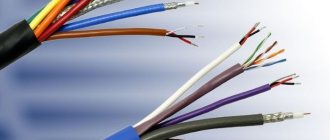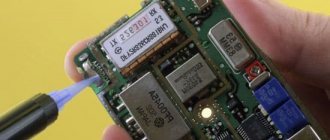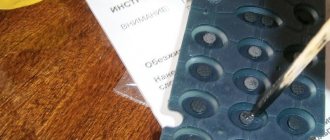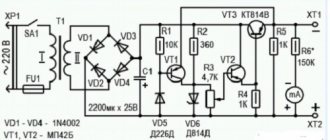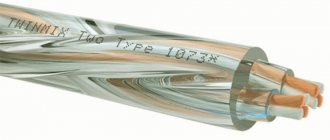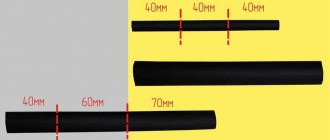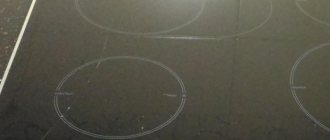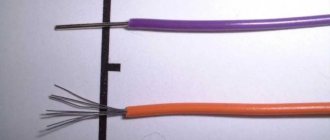Among electrical professionals, conductive varnish, glue and other compounds are popular today. They are used by radio amateurs when assembling microcircuits, in the computer industry, in the production of high-precision equipment, shipbuilding and in other industries.
Using conductive glue on a chip
Electrically conductive glue – buy or make it yourself?
Conductive glue is a handy adhesive for many cars and radio enthusiasts. It is used to repair glass heating filaments in cars, to seal wiring, and to solder contacts in keyboards, remote controls, household appliances, and other devices. An adhesive that does not conduct current may impair the performance of the equipment being repaired.
Features and Properties
The first electrically conductive compound was developed by Germany at the beginning of World War II. Initially it was used only in mechanical engineering. Over time it became universal. Now it is used as a solder when laying heated floors and heating systems, which is due to the ability of the adhesive solution to withstand high temperatures.
- It dries quickly, so gluing must be carried out without interruption.
- It has a high viscosity, which prevents the mixture from flowing into the boards.
- High adhesive characteristics ensure reliable adhesion to the surfaces being processed; it is well fixed on glass, plastic, etc.
- After drying, it can withstand temperatures up to +160 °C while maintaining its structure.
- Safe for humans and nature.
- The elasticity of the composition allows for spot application.
The conductive composition has low electrical resistance. Its use helps protect parts from damage, shock and vibration loads. Thanks to the conductor adhesive, the boards will not react to temperature changes.
Before use, you need to carefully study the composition of the glue and do not use products containing water. The composition and instructions for use are indicated on the original packaging of the glue. For microcircuits, wire contacts, cables, and other electrical elements, the water base is destructive. This composition will take a very long time to dry.
The current-carrying component in the adhesive is often graphite or nickel powder, silver or any other metal. The higher the content of the electrically conductive component, the worse the adhesion of the glue to the surface.
- you can repair computer cables and microcircuits;
- used when installing heating baseboards;
- used as linoleum adhesive when laying antistatic flooring;
- Defects in car electrical systems are eliminated, rear window heating is repaired;
- piezoelements are fastened in radio equipment;
- used when replacing the soldering of light-emitting diodes.
Work with conductive mixtures takes place indoors to minimize environmental pollution.
Areas of application
The scope of application of such glue is truly wide. For example, where working with a soldering iron is impossible, due to the too small size of the parts or their sensitivity to high temperatures, it is simply irreplaceable.
The most popular areas of application of electrically conductive adhesives and varnishes:
- Gluing and restoration of heating filaments on car windows;
- In radio devices - connection of piezoceramic parts;
- For connecting dielectrics through which electrical communications must pass;
- For connecting conductors of too small a cross-section, where hot soldering is simply impossible;
- For “cold” soldering;
- Restoring broken tracks in various devices: keyboards, remote controls, printed circuit boards, etc.;
- Used in the repair of high-tech devices: phones, e-books, computers, etc., for attaching microcircuits and crystals to boards;
- Acts as a base for enamel or paint with conductive properties;
- Restores current conductivity in damaged areas of various devices;
- Used in the installation and repair of electrical heating systems and “warm” floors.
Of course, the possibilities of adhesives and varnishes capable of conducting current are much wider, but the above list is quite capable of impressing with the scope of the capabilities of such a composition.
Choosing glue in the store
Construction and hardware stores have a very wide selection of factory-made electrically conductive glue.
Contactol
Produced in Germany by the Keller concern. 3 products in this series have become famous.
- "Single-component contactol." It is possible to organize or restore a conductive connection on dielectrics (glass, polymers, textolite, etc.). Contains silver and synthetic resins. Has high adhesion and moisture resistance.
- "Kontaktol Radio". The base is graphite powder. The properties are similar to the previous composition, but the price is two times lower.
- "Kontaktol conductive marker". The basis is silver powder, palladium, and PVC resins. It has a convenient release form, you can glue parts in hard-to-reach places. Repair jumpers and conductive paths.
Contactol sets quickly. Complete polymerization of the seam in 6-7 hours. To speed up the final gluing, heat the treated area with warm air.
Permatex
Permatex glue (Permatex) is a two-component composition for the restoration of heating contacts. The connection made is resistant to vibration loads, not subject to ultraviolet radiation and temperature changes. It is better to work with glue at an ambient temperature of at least 10 °C.
It glues carbon fiber, aluminum and stainless steel, and any combination of materials can be used. On the treated area, you can create an electrical connection with a transition resistance. The composition and thickness of TPK-E allows static charges to be removed from the processed part.
Forbo 615 eurostar lino el
Floor coverings (linoleum, carpet) are “slung” onto Forbo electrically conductive glue. This is a translucent composition without a characteristic odor.
Done deal
Done Deal glue is made in the USA and has a polymer-silver composition. Used to restore contacts in cars and to restore heating filaments on windows. High quality adhesive with excellent adhesive properties.
Homakoll
It was developed specifically for gluing floor coverings that are produced in rolls and have a fabric or fleecy backing.
- The composition contains no toxic or volatile components.
- Minimum water content.
- Does not shrink after complete drying.
- After initial adhesion to the surface, the likelihood of shifting and peeling is minimal.
- Easy to apply with a notched trowel.
- Incombustible.
Mastix
Mastix adhesive based on nickel powder. It is used for the restoration of rear window heating threads in cars, filling gaps, cracks and holes, and gluing metal. The characteristics are similar to cold welding.
It is permissible to work at low and high temperatures. The quality of the connection in both cases does not decrease.
VolgaKhimProm
Restoration and reinforcing composition. Complete hardening, depending on the thickness of the applied layer, occurs in a maximum of an hour. Used in everyday life and industry. The glue is safe, without harmful effects on human skin, respiratory tract and mucous membranes.
Other brands
- Conductive adhesive Abro Masters. Produced in the United States of America. Repairing the rear window heating filaments.
- Forbo 523 adhesive for gluing linoleum and other floor coverings. Refers to dispersion compositions, frost-resistant, odorless, does not contain solvents.
- Baku BK 426 is an electrically conductive paste for restoring traces on microcircuits.
- Astrohim. Used in repairing glass heating filaments.
- Irpol 5. Elastic composition based on polyurethane components. Bonds antistatic floor coverings.
- Elekont. Epoxy resin based adhesive. Used when repairing a car. Ineffective, sometimes the application has to be repeated.
DIY conductive glue
Conductive mixtures can be made based on graphite, silver and aluminum.
Graphite based
The easiest way to make conductive glue at home is from graphite. Its main components are pencil lead and nail polish.
You can take the cheapest varnish, it is important that it is transparent, since colored varnishes contain paint that can disrupt the electrical conductivity of the glue. A paste or liquid for gluing false nails is suitable; you can buy the cheapest quick-drying glue, such as “Moment”, “Second”, “Elephant”.
The graphite composition is prepared as follows:
- if you are using nail glue rather than polish, unroll the foil of the tube from the back side;
- remove the lead from a simple pencil, the pencil should be soft (M2, M4);
- grind the lead into a fine powder;
- pour the powder into a tube or bottle;
- mix the ingredients thoroughly with a toothpick;
- Close the tube with the graphite composition again, and clamp the edge with pliers.
If the tube is not closed tightly, the contents may dry out prematurely. Avoid getting air inside. If the resulting glue accidentally spills or is applied unsuccessfully, remove the excess with acetone or nail polish remover.
Graphite can be obtained not only from a pencil. It is found in copper-graphite brushes or salt batteries. You can use sandpaper or a needle file to transform the graphite into powder. The extracted powder can be mixed in a 1:1 ratio with tsaponlak until a creamy mass is formed. An adhesive mixture based on graphite from brushes will be more effective, since it contains an admixture of copper, which increases the electrical conductivity of the product.
Silver based
To make conductive silver-based adhesive, the following components are needed:
- silver nitrate or nitric acid;
Silver and formaldehyde are mixed in equal parts, and then diluted with a few drops of ammonia. After a couple of minutes, a reaction will occur and silver powder will settle to the bottom of the container. To extract it, the liquid is filtered. The resulting powder is dried at a temperature of 120-150 °C.
To make glue, silver powder is added to varnish or glue, as in the instructions for making graphite glue. Before mixing the components, a little alcohol is dripped into the adhesive solution to slightly dilute it.
There are several more recipes.
- Combine 0.13 kg of silver powder and 12 g of graphite. 8 g of nitrocellulose, 0.05 kg of acetone and 3 g of rosin are mixed into them. If the mass is too thick, dilute it with acetone. The product can be used immediately after preparation, but for the most part not for gluing parts, but as an electrically conductive primer.
- 0.03 kg of graphite is mixed with 0.07 kg of silver powder, 0.07 liters of acetone and 0.06 kg of vinyl acetate are poured into the mixture. After mixing the components, an electrically conductive syrup is obtained, which can be used to coat other adhesives, for example, BF.
Aluminum glue
To create it, aluminum powder is added to epoxy glue or resin.
Epoxy polymerizes quickly when a hardener is added, so aluminum powder must be added to the resin before the liquid component is added.
Aluminum and epoxy are mixed until creamy, then a portion of the homogeneous mixture is measured and combined with a hardener in a ratio of 1:10.
Instructions for use
- The surfaces to be bonded are cleaned of dirt and degreased.
- The contents of the tube are stirred until a homogeneous mass is obtained.
- The product is applied to the surface.
- The position of the composition is adjusted by the blade.
- The glue will set in 20 minutes.
If Kontaktol gets on a surface that cannot be glued, the composition can be removed with acetone or ethyl alcohol. To reduce the viscosity, ethyl alcohol is also used, but not more than 20% of the total amount of solution. To reduce the resistance of the adhesive, after it has dried, the surface is rubbed with metal until the adhesive strip gives a metallic shine.
When Kontaktol is needed to repair glass heating filaments, the sequence of actions will be as follows:
- The damaged area is determined.
- The area where the thread breaks is rubbed with fine sandpaper and degreased with a solvent.
- Strips of adhesive tape or masking tape are glued above and below the thread, forming something like a stencil.
- The contents of the flask are mixed for several minutes.
- The product is evenly applied to the broken contact.
- After 30 min. the improvised stencil is removed.
- If possible, dry the glued area with a hairdryer.
- You can use heating a day after applying the glue.
Specifics of using homemade glue
If you need to repair expensive electronics, it is better not to save money and buy high-quality store-bought glue, or even give the equipment into the hands of a specialist. If you need to repair the remote control or have a simpler task, you can prepare a homemade mixture according to the recipes above. This will save you money on buying a ready-made product. The only problem that is typical for all homemade adhesives is that they have a limited shelf life. You need to prepare a small portion, which is used at a time.
Reply to reader
Hello Dmitry! We have the answer to your question, but first, for those readers who do not know what such glue is for, we will give a little introductory information.
Purpose of conductive glue
So, conductive glue is required mainly for radio amateurs and craftsmen who professionally repair household electronics. Very often, for various reasons, breaks form on contacts or conductive paths, which is why the equipment loses some functionality or stops working altogether.
To quickly repair such faults, conductive glue is used for cables. That is, it is applied to the damaged area in a thin strip, without touching adjacent contacts, and after drying, it begins to conduct electricity through the restored circuit.
If you have a radio store within walking distance, then purchasing such a miracle will not be difficult, and the price does not exceed 200 rubles. Among the most popular brands are: Elekont, Kontaktol, Elast (varnish) and others.
But when there are no such stores nearby, finding the compounds becomes problematic. So let's now figure out how to make conductive glue at home with your own hands. The procedure will not take much time and will not require you to use extremely rare components.
Features of conductive adhesive
Before we begin analyzing the recipe, let's figure out what quality the composition should be and what properties it should have.
- It is very important to maintain the correct ratio between the liquid and powder components. For example, if you overdo it with graphite, the glue may begin to poorly adhere to various types of surfaces, and conversely, an insufficient amount of it will lead to an increase in resistance, and as a result, heating of a given point, which is extremely undesirable.
- The next important property that homemade conductive glue should have is fast drying time. The speed of your work will entirely depend on this parameter. Therefore, to make the mixture, it is better to prepare any quick-drying glue or varnish.
Production of conductive glue from graphite
As we have already said, the most accessible conductive dry component is graphite. Therefore, let's figure out how glue is made based on it.
- To work we need only two components. Actually, the graphite itself and the binder.
- We take a simple pencil (preferably a construction pencil, since its core is very thick and soft, which is what we need), split it with a knife and a hammer, placing the blade parallel, and remove the core. The cost of the solution will be from 10 to 20 rubles.
- Grind the graphite rod into powder. To do this, you can use a stationery knife or a fine abrasive, for example, zero-grit sandpaper.
- Take a tube of super glue (let's use it as a base, since it dries very quickly) and carefully unfold the bottom of the tube. If the bottom is sealed or pressed in too well, you can use tin snips to open the tube from that side.
Instructions for use
- The surfaces to be bonded are cleaned of dirt and degreased.
- The contents of the tube are stirred until a homogeneous mass is obtained.
- The product is applied to the surface.
- The position of the composition is adjusted by the blade.
- The glue will set in 20 minutes.
If Kontaktol gets on a surface that cannot be glued, the composition can be removed with acetone or ethyl alcohol. To reduce the viscosity, ethyl alcohol is also used, but not more than 20% of the total amount of solution. To reduce the resistance of the adhesive, after it has dried, the surface is rubbed with metal until the adhesive strip gives a metallic shine.
When Kontaktol is needed to repair glass heating filaments, the sequence of actions will be as follows:
- The damaged area is determined.
- The area where the thread breaks is rubbed with fine sandpaper and degreased with a solvent.
- Strips of adhesive tape or masking tape are glued above and below the thread, forming something like a stencil.
- The contents of the flask are mixed for several minutes.
- The product is evenly applied to the broken contact.
- After 30 min. the improvised stencil is removed.
- If possible, dry the glued area with a hairdryer.
- You can use heating a day after applying the glue.
What is Conductive Adhesive
Glue is a viscous substance that is used to join a variety of materials. There are many types of adhesives, each of them has its own characteristics and properties. Among the most popular are stationery (PVC for papers), linoleum (for flooring), conductive (for various electrical circuits and mechanisms).
Photo - Conductive glue
A conductive two-component adhesive must have the following features:
- Dry quickly, this is necessary for speed of work;
- Have a knitting consistency so that parts of the pattern that do not need to be glued are not damaged during processing;
- Have high adhesion and resistance;
- If you want to use a soldering compound, then you need to choose a heat-resistant glue;
- Be safe for the environment and workers.
This substance is necessary for repairing electrical circuits (keyboards, consumer electronics), constructing various heating mechanisms, floor coverings (warm floors, tiles, glass), etc.
Photo – Elast
You can buy conductive glue without any problems at any construction or electrical store, the average price is from 100 rubles per 25 grams. At the same time, taking into account the consumption, we see the following picture:
- For PVC coatings, the consumption is approximately 250 grams per square meter;
- Non-PVC (textiles, metal) – 400 grams.
It is much cheaper to prepare conductive glue yourself, especially since the components can be bought at any radio store. Let's look at the most popular recipes.
How to make conductive homemade glue
A very common method is where graphite plays a major role. You need to buy the cheapest quick-drying glue (“Moment”, “Elephant”, “Second”) or varnish. Carefully unscrew the foil from the back of the tube, do not damage the seal on the lid. Now we need a soft pencil M4 or M2. We take the lead out of the pencil, knead it thoroughly to the consistency of powder and pour it into a tube of glue. Use a long match to mix our composition and twist the foil; be sure to secure it at the bottom with pliers so that the adhesive does not leak out during operation. The main advantage of graphite compounds is that they dry quickly, but are not suitable for non-ferrous metals that have paint on them. The lead is black, the glue will dissolve it and turn grayish - marks will remain on the surface being treated.
Photo - Graphite conductive glue
You can make homemade opaque glue on silver - this requires a little tinkering. First you need to buy silver nitrate or nitric acid . We also need a 1% formaldehyde solution and ammonia (ammonia). We combine silver nitrate with formaldehyde in equal parts and add a few drops of 5% ammonia. If everything is done correctly, a precipitate will appear - black silver powder; it must be removed from the liquid using a filter and distilled water. Next, we dry the substance at a temperature of 105 to 150 degrees Celsius. We still have black powder that needs to be added to the glue. Many craftsmen recommend dissolving a little alcohol in the glue before starting work, rather than using it a little less often. The composition dries very quickly, so stir it periodically.
Another way to obtain the same powder is to evaporate the composition until crystals appear, and then heat them for half an hour at a temperature of up to 400 degrees. As soon as the substance stops bubbling, the base for the conductive glue is ready. In fact, this is a fairly effective composition, but you can make it yourself either if you have the skills to work as a chemist, or if you have a mini-laboratory at home.
Video: review of conductive adhesives Kontaktol
Additional Recipes
Graphite dust is not the only component that can be used to prepare conductive adhesives. There are several more complex mixtures that have better electrical conductivity or adhesive properties:
- A mixture of silver powder (130 g) and graphite (12 g) are conductive components, and the binders are nitrocellulose (8 g), acetone (50 g) and rosin (3 g). In the order listed, everything is mixed in a mortar until smooth and the glue is ready. If the glue thickens, it must be diluted with acetone. This composition is more designed as conductive - you should not expect it to hold any parts like glue.
- Graphite (30 g) and silver (70 g) powder, acetone (70 ml) and vinyl chloride-vinyl acetate (60 g) - after mixing, they become a syrupy conductive liquid with adhesive properties. Store in an airtight container to prevent the acetone from dissipating. Use it to dilute the mixture if it thickens.
- The powder from the graphite rod of the AA battery and the ceponlac are mixed until a creamy mixture is obtained.
The difference between conductive glue and regular glue
The main difference is that the composition of conductive adhesive requires the presence of certain components that provide the required level of electrical conductivity.
Among the differences we can also highlight:
- lower strength indicators than conventional ones;
- the composition usually contains graphite, metal or both components in a complex;
- the scope of application has its own specifics;
- the cost of such compositions is slightly higher.
Tool requirements
The main quality of conductive glue is high electrical conductivity, which is achieved due to the presence of small metal particles in the substance. For this purpose, manufacturers most often use nickel powder, which conducts electricity well. The glue may contain fractions of gold, silver or palladium. The resistivity value of the product should be minimal.
To ensure that the adhesive properties are not lost during the operation of the electrical appliance, the repair adhesive has a low thermal resistance. In addition, the composition must fulfill its main function and reliably glue surfaces. Polymer binders give elasticity and strength to the substance.
The composition should not be too liquid, because the viscous consistency prevents possible damage to microcircuit elements while working with them. High drying speed is also important for comfortable use.
Conductive Adhesive Brands
There are several manufacturers of conductive adhesive, both foreign and domestic, that guarantee high electrical conductivity.
- Contact. Probably the most famous composition among radio amateurs. Conductive adhesive contactol has high elasticity, sufficient strength, is made on a silver basis and dries quickly, which ensures quick and convenient installation. You can buy conductive glue of this brand in any amateur radio store, however, the professionals in this field themselves speak rather poorly about it. But there are also positive reviews.
Contactol - Elekont. Conductive adhesive that will be useful to every car owner. This is an epoxy compound. Reviews about it are also not encouraging.
Elekont - Done deal. This is a foreign representative of this type of glue. Conductive adhesive done deal has increased reliability and strength, which makes it better than domestic analogues.
Done Deal - Homakoll. A fairly popular brand of conductive adhesive that has long established itself in the market. It is used by large companies as an electrically conductive adhesive for floor coverings with an antistatic effect.
Homakoll - Mastix. This company introduces an electrically conductive adhesive for repairing heated rear windows. Mastix conductive adhesive is considered one of the best in this segment.
Mastix - TPK-E. The brand is distinguished by its technical characteristics. This adhesive will function in a wide range of temperatures. From -190 to +200 °C. Used in enterprises.
Made by yourself
Many novice radio amateurs are wondering how to make conductive glue with their own hands. Here it is necessary to clarify some questions that beginners ask most often.
- Does glue conduct current? This is an adhesive that was developed and introduced by the German company Henkel. A total of 6 compounds were created for various purposes, but none of them conduct current.
- Does super glue conduct electricity? To answer this question, it is necessary to turn to the very concept of an electrically conductive material. Super glue does not contain components that would allow it to be called electrically conductive (graphite, metals), so its performance in this regard is practically no different from plastic.
- Does epoxy conduct electricity? Epoxy resin does not conduct electricity due to the above reason.
- Is it possible to repair high voltage wires using this glue? Masters do not recommend doing this, as it goes against safety rules when working with electricity.
- Why doesn't the contactor work? In modern times, a lot of fakes of this glue have appeared, so it is better to purchase this glue with guarantees from the manufacturer.
- What glue conducts electricity? Any adhesive that contains electrically conductive components in sufficient quantities.
Manufacturing instructions
Recently, radio amateurs have spoken unflatteringly about modern manufacturers of conductive glue. Perhaps it’s all about fakes or the manufacturers themselves provide low-quality goods. In addition, conductive adhesive for microcircuits and other equipment is sometimes needed urgently, and there is no time to purchase or order it. In this case, you can make such a composition yourself using our instructions.
How to make conductive glue? First you need to stock up on the necessary set of materials. He is quite modest:
- a graphite rod from a construction or simple pencil, which will act as the main conductive element in the resulting composition;
- stationery knife;
- a sheet of paper to collect graphite dust;
- hammer;
- container for collecting graphite dust;
- nail polish.
First you need to get a graphite rod. Using a utility knife, grind down the wooden part of the pencil until the graphite lead can be removed. After this, place the rod on a sheet of paper, close it so that the dust does not fly away and use a hammer to grind the lead to dust. This dust will become a conductive element. Collect the dust in a container (an ordinary cap from a plastic bottle is perfect for this). Pour nail polish into the container and mix thoroughly with graphite dust using wooden sticks that may have remained after processing the pencil. Now the conductive glue is ready! The convenience of this glue is that you have the right to make mistakes. Nail polish is easily removed using a special composition.
It should be noted that graphite is not the only material on the basis of which conductive adhesive can be made.
People also know compositions that are based on metal chips or dust. You can use your imagination and remember the school course in chemistry and physics, where they talked about conductive materials. Let's give an example. Graphite is essentially carbon with a characteristic crystal lattice. Carbon is also contained in the products of wood combustion - in soot. For this reason, conductive carbon black adhesive is also quite popular among radio amateurs.
Features of homemade glue
- No one is immune from mistakes. When you do something yourself, you run the risk of doing something wrong, which could result in damaging expensive equipment. Therefore, in some cases it is better to entrust it to professionals and spend money on purchasing a branded composition.
- The reliability of nail polish-based glue is not as high as that of store-bought glue. Remember that such varnish will not serve you forever and early, and its durability will end quite soon.
- Nail polish takes quite a long time to dry compared to store-bought counterparts.
- Homemade conductive glue is much cheaper to make.
- The manufacturing process takes less than 3 minutes, which does not significantly slow down the workflow.
All these facts suggest that it is best to purchase branded conductive glue once and use it for a long time, rather than making your own composition each time, which will quickly fail.
Conductive adhesive is an excellent tool for those who need to quickly and efficiently repair electrical equipment. And only you can decide whether to make glue yourself or buy a reputable brand.
Self-production
Conductive grease can not only be purchased ready-made, but also made with your own hands. However, before giving manufacturing instructions, it is necessary to answer a number of the most common questions among beginners:
- Is Moment glue capable of conducting electricity? No, none of the many variations of this adhesive are capable of conducting current.
- Is Superglue electrically conductive? To answer the question you need to understand the nature of conductivity. This type of substance does not contain components (metals, graphite) that conduct electricity. Thus, in terms of its capabilities, “Superglue” is almost identical to plastic.
- What about epoxy compounds? Epoxy resin does not transmit electricity for the reason stated above.
- Are high-voltage repairs using specialized glue allowed? No, such work is prohibited in accordance with safety regulations.
- I bought Kontaktol, but it does not give the desired effect. The reason is most likely that the product is counterfeit. The popularity of this brand has led to a large number of counterfeits.
- What is needed for the electrical conductivity of the composition? The adhesive must necessarily contain conductive components. Moreover, their specific gravity must be sufficient to ensure electrical conductivity.
Manufacturing instructions
This part of the article will talk about how to make conductive glue with your own hands. The desire to make the composition yourself is often dictated by the unsatisfactory quality of store purchases. In addition, sometimes an adhesive composition is needed urgently, and there is simply no time to find it on sale. In this case, you can make glue with your own hands according to the instructions below. To make it you will need:
- First of all, you need to prepare a base on which homemade conductive glue will be made. We will use a graphite pencil lead as such a base. This rod will become a conductive element.
- Stationery knife.
- Hammer.
- A piece of paper on which we will collect graphite dust.
- A glass or other container for graphite dust.
- Nail polish.
Before making conductive glue, you need to remove the graphite from the pencil. To do this we use a stationery knife. Next, place the rod on the paper, cover it on all sides so that dust does not scatter to the sides. Using a hammer, grind the graphite until it turns into dust.
We collect dust in a clean and dry container prepared in advance. Pour nail polish into a glass and stir the mixture with a wooden stick (you can use, for example, an unnecessary pencil). That's it - the conductive composition is ready.
other methods
Conductive gel or varnish can also be made from metal chips or dust. The fact is that graphite is carbon with a special crystal lattice. Carbon is found in combustion products, for example, in soot.
Silver can also be used as conductive elements, although the method is quite labor-intensive. First you need to purchase silver nitrate or regular nitric acid. You will also need 1% formalin solution and ammonia.
After combining silver with formaldehyde in equal parts and a few drops of ammonia, a characteristic black precipitate will appear - this is silver. The metal is extracted by filtration in distilled water. We dry the metal at high temperature - from 100 to 150 degrees above zero. The resulting powder will become the basis of the adhesive. To make the composition more liquid (then it will dry more slowly), the glue can be diluted with a small amount of alcohol.
There is another way to make conductive glue with your own hands. Silver powder can be obtained by evaporation: the process is carried out until crystals appear. Next, heat the substance at 400 degrees for 30 minutes. As a result, bubbles will appear, which will indicate the readiness of the substance. The method is considered very effective, but not readily available at home. In addition, certain skills in working with chemicals are required.
